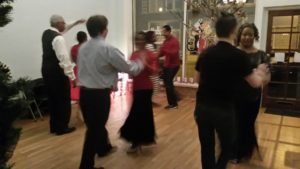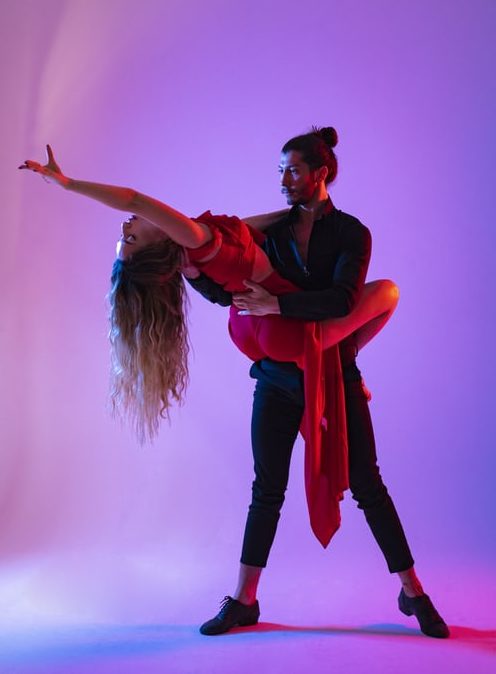What to do (or not do) on the dance floor.
Just exercising common courtesy will go a long way on the dance floor, but there are a few ballroom specific things you might want to know.
Navigating the Floor
First of all, where should you be on the floor? For spot dances (swing, rumba, etc.) it really doesn’t matter. Any open space is fine (*usually). But for travelling dances (waltz, foxtrot, etc.) there is a structure similar to a racetrack. If you aren’t moving at all, stay in the center. Move out a little when you are ready to progress and utilize the periphery when you have the skill to move quickly and navigate effectively. And always keep in mind that the flow is counterclockwise, so you don’t end up going the wrong way on a one-way street. [*Some songs are appropriate for multiple dances, so even if you are doing a spot dance, be aware if others are travelling. In other words, don’t do swing in the foxtrot lane.]
Asking For/Accepting a Dance
It is a convention when at a ballroom event to dance with a variety of partners. This is partly to ensure that everyone has a good time, and partly to improve your own dancing. You can dance with more accomplished partners to elevate your own skills, then pay it back by dancing with the less experienced. If you are part of a group, try to dance with everyone at least once. If you’re on your own, spend some of your dances on the wallflowers. Not only is it kind, but you may find yourself pleasantly surprised by the experience. You don’t need to avoid approaching someone who is clearly part of a couple, but it is generally a good idea to ask their partner if they mind. Most don’t, but it’s better to ask. And if you are the one being asked, say yes unless there is a compelling reason not to. You don’t have to subject yourself to a partner that is known to be handsy or has extreme body odor, but don’t reject someone because they are inexperienced, socially awkward, or not part of your immediate circle. Again, you might be surprised.
After the Dance
Once you have asked someone to dance you should escort them onto the floor and back off again afterward. Simply walking away and leaving someone standing alone on the floor is rude and probably won’t get you many second dances. When the music ends, thank your partner, offer your arm, and return them to their seat. You may be a little less formal with someone you know well and dance with often, but it’s always appropriate to show appreciation for your partner.
Partnership
Always strive to complement your partner. For the leader that means not being rough or trying to force patterns far beyond your partners current capabilities. Making someone look good and feel comfortable is far more effective than showing off every move you know on someone who isn’t ready for them. Being able to assess a partner’s competency is a valuable skill, and dancing at (or slightly above) their level will make them feel accomplished and you look like a good leader.
As for followers, they should follow. It may be tempting to try and anticipate your partner’s next move. It’s also hard to resist “helping” a leader who seems to be struggling. Neither makes you or your partner a better dancer. Also, avoid breaking out things like dramatic styling or advanced syncopations on inexperienced partners. It will confuse and short-circuit them. Instead, concentrate on perfecting the basics and save the frills for someone who can match and appreciate them.
And no matter what, avoid blaming and complaining. Even if you’re right, it won’t make you very popular. It’s far too common (and a particular pet peeve of mine) to hear weak dancers complaining about the perceived inadequacies of their partners. You will always be sought-after and admired if you concentrate on improving your own skill and are generally kind and encouraging to others.
Showing Off
Save the tricks for performances. Full body drops, lifts, and the like have no place in social dancing. That kind of behavior is potentially dangerous, intimidates beginners, and irritates experienced dancers. If you’re truly a good dancer, you don’t need to prove it by slinging someone over your head on a crowded floor.
Collisions
Even the best dancers following all the rules will occasionally bump into one another. So will you. Often it is unclear who bumped into whom. Never try to assign blame. Simply say “excuse me” (or gracefully acknowledge the apology if you where clearly the bumpee) and move on. If you do encounter the rare aggressive (or oblivious) dancer that frequently plows into others, it is best to simply avoid them.
Common (Or Not) Sense
And finally, a few general guidelines that apply whether in a lesson or at a gala. They may seem like common sense, but experience tells me they still bear mentioning.
- Don’t eat garlic or onions beforehand (unless everyone does), and don’t convince yourself that you can cover it up with a swig of mouthwash.
- Take a shower and wear clean clothes.
- Carry gum or mints.
- Don’t douse yourself in cologne/perfume.
- Put away the cell phone (unless you’re a surgeon or volunteer fireman on call) and pay attention to the people you’re with.
Now you know, so go out and have fun!
More Articles That Might Interest You
Is That Step Legit | Understanding the Ballroom Syllabus System
Three Dances Everyone Should Know How to Do
And if you want to see real people dancing in the wild, then our Gallery blog is just the inspiration you need.
Three Easy Ways to Find Out More About Lessons
Visit our Lessons page.
Contact us at (901) 359 – 6467 or cat@catsballroom.com
Try a free lesson to see if you like it. We know your will 😉






